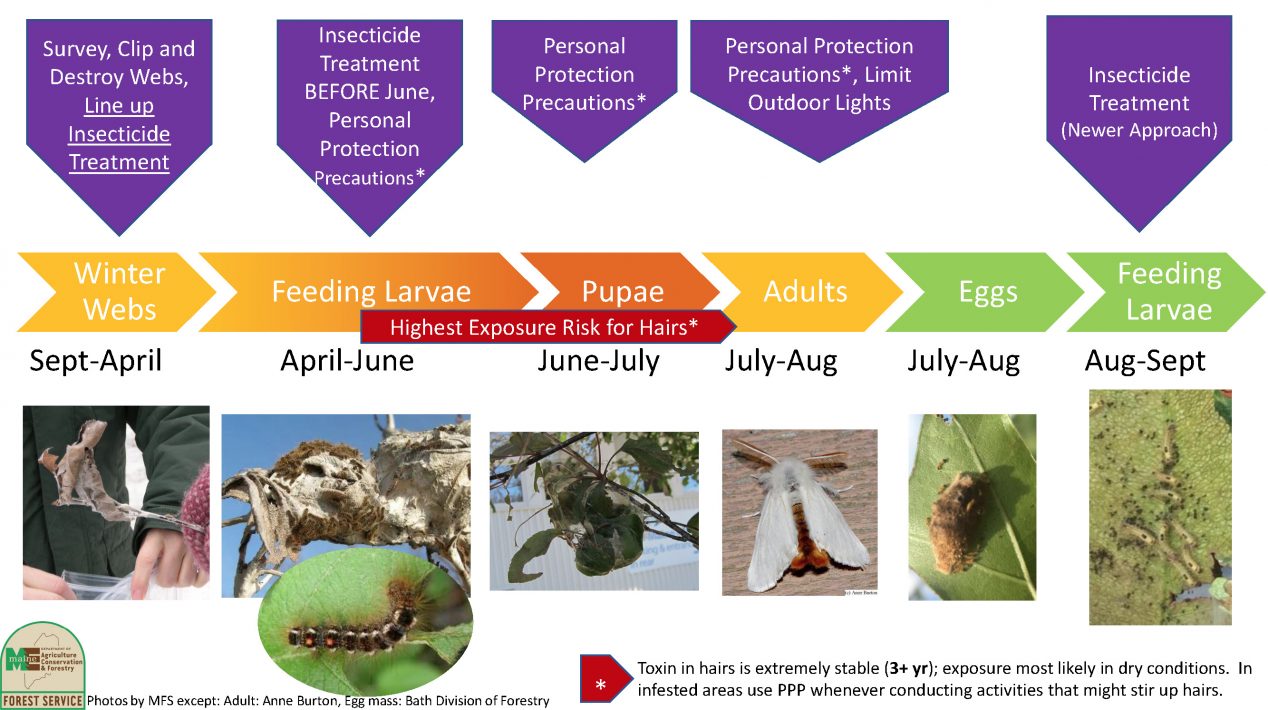Brown tail moth population has increased in Central Maine in recent years.

An invasive species from Europe, brown tail moths first arrived in Massachusetts in 1890. In recent decades, they have been primarily located on the coast and islands of Maine and some parts of the Massachusetts coast. Since 2015, their population has sharply increased, with heavy infestations becoming increasingly present throughout Central Maine.
Brown tail caterpillars feed primarily on oak and fruit trees.
Brown tail moth infestations can defoliate trees, which can cause dieback and even kill them after several years of defoliation.
As you can see in the below graphic from the Maine Forest Service, brown tail moth overwinter as tiny caterpillars in nests made out of webbing and leaves that are typically found at the top of the tree.
In April, the caterpillars hatch from their eggs and begin to feed on leaves. During this phase, you will begin to experience varying levels of irritation and tree defoliation depending on the size of your area’s brown tail population. It is necessary that trees are treated by the end of May to affect this season’s brown tail population.
In June, the caterpillars will enter cocoons and remain there until July, when they will exit their cocoons as moths and begin mating. During this time, it is important to minimize or eliminate your outdoor lighting, as moths with gravitate to your lights and choose that location to lay eggs.
As soon as late July, the moths will lay eggs in the leaves of primarily oak and fruit trees. These eggs will hatch in August, and the newly hatched caterpillars will feed until September, at which time they will form their overwintering nests and remain there until next spring. Trees injected before these tiny caterpillars finish feeding will significantly reduce if not eliminate their individual brown tail populations.

Maine Department of Agriculture, Conservation, & Forestry
There are three primary forms of control for brown tail moths: pruning nests, spraying, and injecting. While we have many competitors who offer pruning and spraying services, we only inject, and for several good reasons:
- Injecting is often far more cost-effective than pruning per tree.
- Both pruning and spraying must be done every year to ensure effectiveness, while injected trees control brown tail populations for two years.
- Chemicals sprayed on to a tree will wash off with the next rainstorm, immediately losing their effectiveness.
- When injecting, virtually the entire chemical is contained within the tree, preventing exposure to neighbors, family members, and pets, while spraying comes with a much higher risk of exposure to the surrounding area.
- Properly injected trees take up the product evenly, ensuring maximum effectiveness, while spraying and pruning have a higher risk of missing feeding caterpillars.
We measure each tree’s diameter, which tells us the amount of chemical to use. We then drill holes around the base of the tree and pump the pesticide emamectin benzoate into these holes. The chemical is then brought up into the leaves, killing feeding caterpillars. Drilling the holes does not harm the tree, and these holes fully heal within three years.
We treat for brown tail moth from April to September. The results for treatments applied after May will be most noticeable the following Spring, when the tiny feeding caterpillars are exterminated in the fall before they can build their overwintering nests.